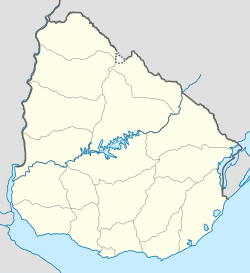San José de Mayo
San José de Mayo | |
|---|---|
Capital city | |
      From top, left to right: view of the Cathedral, the Macció Theater, the City Hall, monument of José Artigas in the Independence Square, the Treinta y Tres Orientales Square and the station. | |
 San José de Mayo Location in Uruguay | |
| Coordinates: 34°20′0″S 56°43′0″W / 34.33333°S 56.71667°WCoordinates: 34°20′0″S 56°43′0″W / 34.33333°S 56.71667°W | |
| Country | |
| Department | San José Department |
| Founded | 1783 |
| Population (2011 Census) | |
| • Total | 36,743 |
| • Demonym | maragato-a |
| Time zone | UTC -3 |
| Postal code | 80000 |
| Dial plan | +598 434 (+5 digits) |
| Climate | Cfa |
San José de Mayo (Spanish pronunciation: [saŋ xoˈse ðe ˈmaʝo]) is the capital city of the San José Department in southern Uruguay.
Location and geography[]
The city is located at the centre of the state, on the intersection of Route 3 with Route 11, 90 kilometres (56 mi) from the centre of Montevideo. The railroad track connecting Montevideo with Colonia and with the northwest of the country passes through the city. The river Río San José flows along the northeastern and eastern limits of the city.
History[]
San José de Mayo was founded on 1 July 1783. It had acquired "Villa" (town) status before the Independence of Uruguay, which was elevated to "Ciudad" (city) on 12 July 1856 by the Act of Ley Nº 495.[1] During the 19th century it became a commercial and cultural centre, known as "Montevideo chico" ("little Montevideo"). The theatre "Teatro Macció" was constructed at the turn of the 20th century.
Population[]
In 2011 San José de Mayo had a population of 36,743.[2]
| Year | Population |
|---|---|
| 1867 | 3,224 |
| 1908 | 12,297 |
| 1963 | 27,482 |
| 1975 | 28,554 |
| 1985 | 31,825 |
| 1996 | 34,552 |
| 2004 | 36,129 |
| 2011 | 36,743 |
Source: Instituto Nacional de Estadística de Uruguay[1]
Places of worship[]
- Cathedral Basilica and National Sanctuary of St. Joseph (Roman Catholic)
- (Roman Catholic)
- (Roman Catholic)
- (Roman Catholic)
Economy[]
Besides being the administrative capital of the department, the city is an active regional commercial and financial centre. Its economy is linked mainly to cattle ranching, and it is an agro-industrial centre for dairy products, packing houses, mills, and chemicals.
References[]
- ^ Jump up to: a b "Statistics of urban localities (1867–2004)" (PDF). INE. 2012. Retrieved 5 September 2012.
- ^ "Censos 2011 Cuadros San José". INE. 2012. Archived from the original on 9 March 2013. Retrieved 25 August 2012.
External links[]
| Wikimedia Commons has media related to San José de Mayo. |
- Populated places in the San José Department
- Populated places established in 1783
- Uruguay geography stubs

